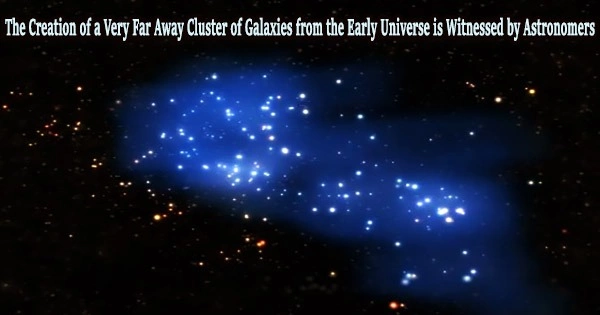Astronomers have found the largest store of hot gas to date in the still-forming galaxy cluster around the Spiderweb galaxy using the Atacama Large Millimeter/Submillimeter Array (ALMA), of which ESO is a partner. Galaxies are among the largest things known to exist in the universe, and this finding, which was published in Nature Today, shows just how early these structures start to emerge.
As the name implies, galaxy clusters house hundreds or perhaps thousands of galaxies. They also contain a vast “intracluster medium” (ICM) of gas that permeates the space between the galaxies in the cluster.
This gas in fact considerably outweighs the galaxies themselves. Although the physics of galaxy clusters is largely understood, there are still few observations of the ICM’s earliest stages of development.
Previously, the ICM had only been studied in fully-formed nearby galaxy clusters. Astronomers could observe galaxy clusters that are still forming in the early phases of creation by finding the ICM in distant protoclusters.
A team led by Luca Di Mascolo, first author of the study and researcher at the University of Trieste, Italy, were keen to detect the ICM in a protocluster from the early stages of the Universe.
Since they are so large, galaxy clusters can collect heated gas that is falling toward them.
We will be able to look within protoclusters with the ELT and its cutting-edge instruments, such HARMONI and MICADO, and learn a great deal about the galaxies there. This will give an essential window into how some of the greatest structures in the early Universe were put together, especially when combined with ALMA’s ability to follow the emerging ICM.
Mario Nonino
“Cosmological simulations have predicted the presence of hot gas in protoclusters for over a decade, but observational confirmations has been missing,” explains Elena Rasia, a researcher at the Italian National Institute for Astrophysics (INAF) in Trieste, Italy, and co-author of the study. “Pursuing such key observational confirmation led us to carefully select one of the most promising candidate protoclusters.”
That was the Spiderweb protocluster, located at an epoch when the Universe was only 3 billion years old. Despite being the most intensively studied protocluster, the presence of the ICM has remained elusive.
The presence of a significant hot gas reservoir in the Spiderweb protocluster would suggest that the system is forming into a stable galaxy cluster as opposed to dispersing.
Di Mascolo’s team detected the ICM of the Spiderweb protocluster through what’s known as the thermal Sunyaev-Zeldovich (SZ) effect. When light from the cosmic microwave background a remnant of the Big Bang passes through the ICM, this phenomenon takes place. This light gains some energy and changes slightly in color or wavelength when it interacts with the swiftly moving electrons in the heated gas.
“At the right wavelengths, the SZ effect thus appears as a shadowing effect of a galaxy cluster on the cosmic microwave background,” explains Di Mascolo.
Astronomers can therefore deduce the presence of the hot gas, calculate its mass, and map its shape by observing these shadows on the cosmic microwave background.
“Thanks to its unparalleled resolution and sensitivity, ALMA is the only facility currently capable of performing such a measurement for the distant progenitors of massive clusters,” says Di Mascolo.
Scientists discovered a large store of hot gas at a temperature of a few tens of millions of degrees Celsius inside the Spiderweb protocluster. This protocluster has been previously reported to contain cold gas, but the hot gas discovered in this latest study dominates it by thousands of times in mass.
This discovery demonstrates that the Spiderweb protocluster is in fact anticipated to evolve into a huge galaxy cluster in the vicinity of 10 billion years, increasing its mass by a factor of at least ten.
Tony Mroczkowski, co-author of the paper and researcher at ESO, explains that “this system exhibits huge contrasts. The hot thermal component will destroy much of the cold component as the system evolves, and we are witnessing a delicate transition.” He concludes that “it provides observational confirmation of long-standing theoretical predictions about the formation of the largest gravitationally bound objects in the Universe.”
These results help to set the groundwork for synergies between ALMA and ESO’s upcoming Extremely Large Telescope (ELT), which “will revolutionise the study of structures like the Spiderweb,” says Mario Nonino, a co-author of the study and researcher at the Astronomical Observatory of Trieste.
“We will be able to look within protoclusters with the ELT and its cutting-edge instruments, such HARMONI and MICADO, and learn a great deal about the galaxies there. This will give an essential window into how some of the greatest structures in the early Universe were put together, especially when combined with ALMA’s ability to follow the emerging ICM.”





